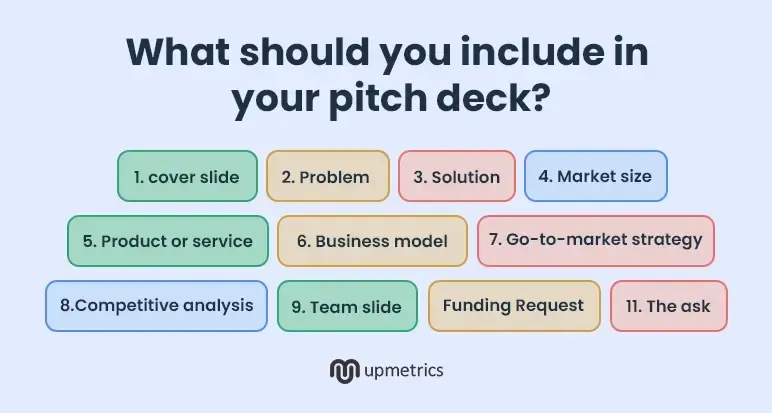If you’re a graduate or a small business owner, chances are you’ve got innovative ideas constantly spinning in your mind. And well—that’s a great start toward entrepreneurship!
But when it comes to turning those ideas into reality, you’ll need solid funding. To get that, you must convince potential investors to believe in your idea and inspire them to invest in your venture. And this is exactly where a well-crafted pitch deck can work wonders.
Now, the big question: How do you create a pitch deck that actually impresses investors? Is a pitch deck a visual slide presentation? If yes, then what slides should you include, and how should you present them? Don’t worry—this blog is your go-to guide for everything you need to know, including the answer to: What is a pitch deck, what it includes, and how to build one.
So, let’s dive in and get started!
What is a pitch deck?
A pitch deck is a short, visual presentation that explains your business idea to potential investors, partners, or clients.
It’s usually made in the form of a slide deck, like a PowerPoint or PDF, and it highlights the most important parts of your business, such as:
- The problem you’re solving
- How you’re solving it
- Your business model
- Your market opportunities
- People leading your team
- The amount you need to grow
Remember, it’s not just another business plan filled with pages of text. It’s more of a narrative that you present with slides—simple, concise, and persuasive.
The objective is simple: To get people interested in your business, open the door to more conversations, meetings, or investment, and communicate your business idea clearly in an interesting, uncomplicated manner.
Having learned the meaning of pitch deck, now let’s talk about its importance in the following section..
Why do we need a pitch deck if we have a business plan already?
You may wonder, why do I need a pitch deck if I’ve already spent so long making a complete business plan? The pitch deck and the business plan actually serve different needs, and they complement each other.
A business plan is typically a long-form document (dozens of pages) that dives into every detail of your business, great for deep due diligence or internal planning.
However, you wouldn’t hand a 40-page business plan to an investor in an initial meeting. This is where the pitch deck comes in.
Think of your business plan as the full script or blueprint, and the pitch deck as the highlight reel.
The pitch deck’s purpose is to summarize the most important and exciting parts of your business plan in a brief, digestible format.
It’s the storytelling tool you use to capture attention and convey your venture’s essence within minutes. Investors will often look at your deck first to decide if they’re interested enough to read further or schedule a meeting.
If your pitch deck does its job, those investors will ask for your business plan or more detailed information afterwards.
So, in simple words:
Pitch Deck = First impression, storytelling tool, meeting opener.
Business Plan = Full story, detailed roadmap, decision-making tool.
You can’t really have one without the other if you’re serious about raising funds or growing a proper business. The pitch deck gets them to the table, and the business plan closes the deal.
Ditch your old-school pitch deck creation methods
Make compelling pitch decks in minutes with AI
Plans starting from $14/month

What should you include in your pitch deck?
Now that you know the pitch deck meaning and why it’s important, even if you have a business plan, let’s talk about what actually goes into a pitch deck. Let’s get started.

Cover Slide
It’s an opener for your deck. Hence, keep it visually appealing, clean, professional, and simple. Remember, this slide sets the tone; hence, make it impactful.
Add your business name, logo, tagline, and maybe a powerful image that captures the essence of your idea. It’s like a handshake—first impressions matter.
Problem
Explain what real problem you’re solving. Investors care about problems because problems create demand.
Keep it simple and relatable. If possible, throw in a stat or a short real-life example to make it hit home.
Solution
Now that you’ve shown the problem, tell them how your product or service solves it.
Be clear and crisp—no jargon. This is where you show how your idea makes life better, easier, or cheaper for people.
Market size
You need to show them how big the opportunity is.
Is it a $100 million market or a $10 billion one? The bigger the market, the bigger the opportunity for scaling and profit, and that’s what investors look for. Use clear numbers, and keep it visual; charts and graphs work great here.
Product or service
Introduce what you’re selling in a way that’s easy to understand.
If it’s an app, show screenshots. If it’s a product, add photos. If it’s a service, explain the process in a few bullet points.
Help them picture it.
Business model
This is where you answer how you’ll make money. Is it through subscriptions? One-time purchases? Advertising? Explain it simply.
If you’ve already made some money, show it off here.
Go-to-market strategy
Alright—so you’ve got a great product. But how will you reach your customers?
This slide explains your marketing and sales game plan. Will you use social media? Partner with stores? Online ads?
Competitive analysis
Show that you’ve done your homework.
List your main competitors and explain what makes you better or different.
You can use a simple table or a graph to compare features, pricing, or market share. It shows investors you understand the battlefield.
Team slide
People invest in people, not just ideas.
Introduce your core team members—names, photos, roles, and a quick line on what makes them awesome for this project.
If you’ve got advisors or industry veterans backing you, mention them too.
Financials
You don’t need to drown them in spreadsheets, but give them a clear snapshot of your revenue, expenses, and profit projections for the next 3-5 years.
It shows you’re serious and have thought through the numbers. Remember, only 58% of successful pitch decks include a financial slide, yet it’s the very first slide investors tend to check out!
The ask
This is your closing punch.
Tell them how much money you need and what you’ll use it for—like marketing, hiring, product development, etc.
Be specific and confident. No one likes a vague ask.
For more detailed information on what to include in a pitch deck, check out our blog on the process of making an investor-ready pitch deck.
When should you build a pitch deck?
You shouldn’t build a pitch deck until you have complete clarity on three things:
- Your business model—how you’ll make money.
- Your target market—who exactly you’re solving the problem for.
- Your traction or go-to-market plan—how you’ll reach those people and start getting them to buy.
A pitch deck isn’t something you throw together at the idea stage. It comes after you’ve properly thought through your business plan—or at least after you’ve nailed down what you’re building, who it’s for, and how you’ll get paid.
So, when’s the right time to build one?
Here are a few signs to watch for:
You’re ready to raise money
If you’ve hit a stage where you need funding to grow, hire, build your product, or enter the market, it’s pitch deck time.
You have real customer insights
When you’ve spoken to actual potential customers, validated the problem, and maybe even have some early adopters interested, you’ll have meaningful content for your pitch deck.
You’ve seen early traction
Maybe you’ve made a few sales, got some app downloads, or have a waiting list. Any small win that proves people want what you’re offering makes your pitch deck 10x stronger.
You can clearly explain your business in 10–12 slides
If you can confidently tell your business story, the problem, solution, market, how you’ll make money, and what you need—in a dozen slides without getting stuck, that’s another green light.
Remember, the pitch deck isn’t where you figure things out. It’s where you show that you already have.
Better to take your time getting your basics right first than to show up with a half-baked pitch. Investors spot that stuff a mile away.
Types of pitch decks and when to use them
Not every pitch deck is meant for the same audience or situation. Let’s break down the different types of pitch decks you might need and what makes each one useful.
1) Investor pitch deck
Use an investor pitch deck when you’re actively raising funds, meeting potential investors, or presenting to VCs and angel groups. Such pitch decks clearly explain your business opportunity, how you’ll make money, and why it’s worth betting on. Get more details on the investor pitch deck, and check out our blog on the process to pitch investors.
| Audience | Angel investors, VCs, and potential funders |
| Number of Slides | 10–15 slides |
| Purpose | To pitch your business for funding |
| Format style | Clean, focused, numbers-backed |
2) Demo day deck
Ideal for startup demo events, accelerators, competitions, or any situation where you have just a few minutes to impress a crowd. This pitch deck is designed to be fast, visual, and exciting—hitting the big highlights like the problem, your solution, and why it matters.
| Audience | Audience at startup demo events |
| Number of Slides | 5–7 |
| Purpose | Quick showcase to spark interest |
| Format style | Highly visual, bold points |
3) Internal pitch deck
Use an internal pitch deck to align your co-founders, team members, or board on strategy, product roadmaps, performance updates, or new initiatives. Such a pitch deck can be the best way to keep everyone on the same page, track progress, and make sure your team’s energy is focused on the right priorities.
| Audience | Your co-founders, team, or board members |
| Number of Slides | 10–12 |
| Purpose | Align internal strategy and goals |
| Format style | More detailed and actionable |
4) Email pitch deck
Perfect for sending a lightweight, skimmable pitch via email to potential investors, advisors, or mentors to spark their interest and get a meeting.
| Audience | Busy investors, mentors, or advisors via email |
| Number of Slides | 8–10 |
| Purpose | To get meeting requests or initial interest |
| Format style | Brief, skimmable, and light text |
5) Partnership deck
Use this when pitching to brands, distributors, influencers, or partners to propose a win-win collaborative opportunity. This pitch illustrates how both parties can win, why you’re unique in value, and how collaboration can lead to new doors opening.
| Audience | Potential business partners or collaborators |
| Number of Slides | 8–10 |
| Purpose | To pitch a collaboration or a strategic partnership |
| Format style | Benefit-driven and mutual gain-focused |
What works and what doesn’t in a pitch deck?
Before you jump into designing slides, it’s smart to know what makes a pitch deck click with investors — and what turns them off. Let’s keep it simple and clear.
What works? ✅
Here’s what you should include or do to impress your audience through your pitch deck:
Keep it short and sharp
Investors are busy people. They don’t have time for 30-slide stories. Aim for 10–12 slides that get to the point without dragging. Every slide should earn its place. If it’s fluff, cut it.
Lead with a strong problem-solution story
Start by showing a real, painful problem in the market—something people genuinely struggle with. Then introduce your solution like a hero in the story. Investors back problem-solvers, not just ideas.
Use clean, simple visuals
Nobody wants to read slides filled with paragraphs. A good chart, image, or icon can explain in seconds what a paragraph takes minutes to digest. Make it easy for their eyes and brains.
Highlight the market opportunity clearly
Show how big the playground is. Is it a $50 million market or a $5 billion one? Bigger markets mean bigger returns. Investors get excited when they see the potential scale of your business.
Back every claim with real numbers
Don’t just say “we’re growing fast”, show the actual growth. Whether it’s user numbers, revenue, or sign-ups, data builds credibility. It proves you’re not all talk.
Introduce your team and why they matter
Ideas are easy, but execution is hard. And execution depends on people. Show who’s on board, what makes them capable, and why this team can pull it off better than anyone else.
End with a clear, confident ask
Don’t leave them guessing. Tell them exactly how much you’re raising and what you’ll do with it. Confidence in your ask shows you know what you’re doing.
What doesn’t work? ❌
Here’s what you should not include in your pitch deck:
Overcrowded slides loaded with text
If your slide looks like a Word document, it’s a problem. Investors don’t read dense slides. Keep your points short, clean, and easy to skim.
Throwing around bold claims with no proof
Saying things like “we’ll be the next Uber” without showing any evidence makes you look naïve. Back every bold statement with data or real traction.
Overcomplicating your business model
If you can’t explain how you make money in one simple slide, it means you probably don’t understand it well enough. Keep it simple, clear, and believable.
Ignoring your competitors
Pretending you have no competition is a rookie mistake. Investors know every market has alternatives. Be smart, show your competitors, and explain how you’re better or different.
Getting lost in technical product details
Unless you’re pitching to hardcore engineers, most investors care about the market opportunity, traction, and business model first. Keep the tech talk light unless it’s a game-changer.
Poor design and cluttered visuals
Clean, well-made slides show that you actually respect your audience’s time and that you’ve put real thought into what you’re sharing.
If you’re not sure what to include or leave out, just check out a few pitch deck examples. They’re a great way to see how other startups lay things out, tell their story, and focus on the things investors care about most.
Build a strong pitch deck with Upmetrics
A pitch deck’s a pretty big deal. If you nail it, it can open doors you didn’t even know were there. But if you miss the mark, though, you might end up off track without realizing it.
The good news is you don’t have to figure it all out alone. Upmetrics’ AI pitch deck generator can guide you through building a clear, solid presentation that shows off your strengths, tells your story the right way, and makes investors pay attention.
Not bad, right? And it doesn’t stop there—Upmetrics stands by your side across every business planning milestone, whether it’s writing a professional business plan, financial forecasting, or strategic planning.
So ready to craft an impressive pitch deck? Try Upmetrics today!

